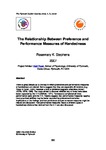The Relationship Between Preference and Performance Measures of Handedness
| dc.contributor.author | Stephens, R. | |
| dc.date.accessioned | 2018-11-08T13:00:29Z | |
| dc.date.accessioned | 2018-11-19T12:21:51Z | |
| dc.date.available | 2018-11-08T13:00:29Z | |
| dc.date.available | 2018-11-19T12:21:51Z | |
| dc.date.issued | 2008 | |
| dc.identifier.citation |
Stephens, R. (2008) 'The Relationship Between Preference and Performance Measures of Handedness', 1 (1), p. 63-94 | en_US |
| dc.identifier.issn | 1754-2383 | |
| dc.identifier.uri | http://hdl.handle.net/10026.1/12805 | |
| dc.description.abstract |
There is great debate as to the way in which preference and performance measures of handedness are related. Some suggest that they are separable dimensions (e.g. Porac & Coren, 1981), however a bulk of evidence suggests otherwise (Annett, 1970b; 1976; 1985). The study aimed to discover whether any of three tasks were better captured by the EHI (Oldfield, 1971). Participants completed all three performance tasks and the EHI. Results suggest that performance measures tapping more practiced abilities may be better captured by preference inventories. Implications of the findings and how preference and performance measures might be related are discussed. How performance measures relate to different types of handedness dichotomies derived from the EHI are also discussed. | en_US |
| dc.language.iso | en | en_US |
| dc.publisher | University of Plymouth | |
| dc.rights | Attribution 3.0 United States | * |
| dc.rights.uri | http://creativecommons.org/licenses/by/3.0/us/ | * |
| dc.title | The Relationship Between Preference and Performance Measures of Handedness | en_US |
| dc.type | Article | |
| plymouth.issue | 1 | |
| plymouth.volume | 1 | |
| plymouth.journal | The Plymouth Student Scientist |



